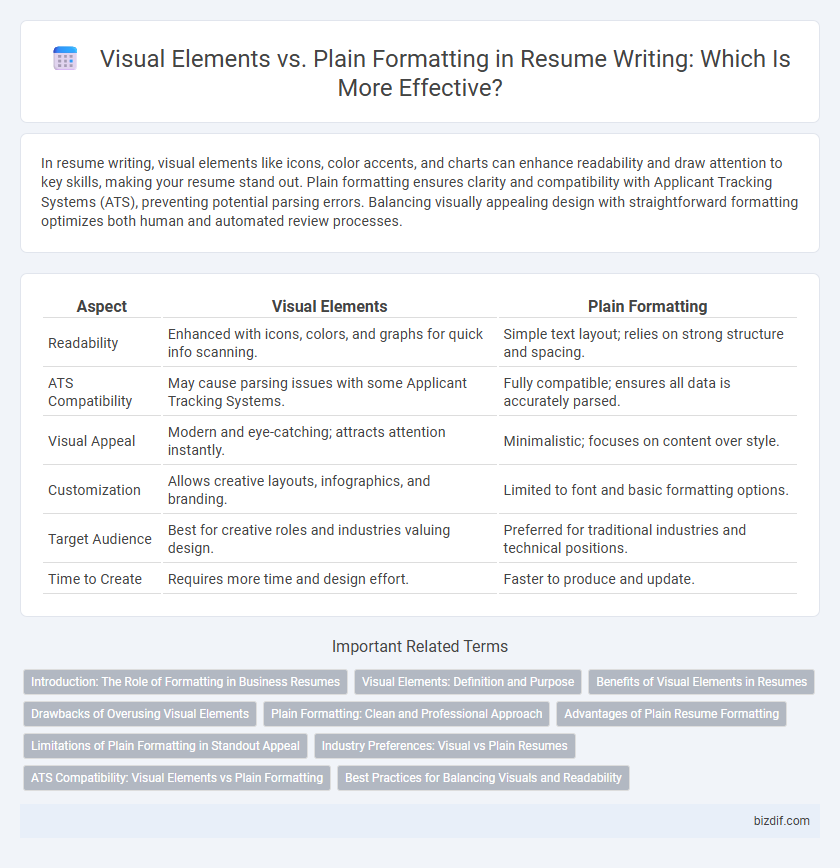In resume writing, visual elements like icons, color accents, and charts can enhance readability and draw attention to key skills, making your resume stand out. Plain formatting ensures clarity and compatibility with Applicant Tracking Systems (ATS), preventing potential parsing errors. Balancing visually appealing design with straightforward formatting optimizes both human and automated review processes.
Table of Comparison
| Aspect | Visual Elements | Plain Formatting |
|---|---|---|
| Readability | Enhanced with icons, colors, and graphs for quick info scanning. | Simple text layout; relies on strong structure and spacing. |
| ATS Compatibility | May cause parsing issues with some Applicant Tracking Systems. | Fully compatible; ensures all data is accurately parsed. |
| Visual Appeal | Modern and eye-catching; attracts attention instantly. | Minimalistic; focuses on content over style. |
| Customization | Allows creative layouts, infographics, and branding. | Limited to font and basic formatting options. |
| Target Audience | Best for creative roles and industries valuing design. | Preferred for traditional industries and technical positions. |
| Time to Create | Requires more time and design effort. | Faster to produce and update. |
Introduction: The Role of Formatting in Business Resumes
Effective formatting in business resumes enhances readability and highlights key qualifications through visual elements like bullet points, bold text, and strategic white space. Plain formatting, while clean and straightforward, may fail to capture attention in competitive job markets where recruiters scan dozens of resumes quickly. Incorporating visual elements without overloading the document ensures a professional appearance and improves overall impact.
Visual Elements: Definition and Purpose
Visual elements in resume writing include graphics, icons, charts, and colors designed to enhance readability and highlight key information. These elements guide the recruiter's eye to critical sections such as skills, achievements, and contact details, improving overall engagement. Incorporating visual components strategically can differentiate a resume, making it memorable and reflecting a candidate's attention to detail and creativity.
Benefits of Visual Elements in Resumes
Visual elements such as icons, charts, and color accents enhance resume readability by guiding the recruiter's eye to key information quickly. Incorporating infographics and bullet points improves information retention and highlights achievements effectively. Visual formatting also differentiates candidates by showcasing creativity and professionalism, increasing the chances of passing applicant tracking systems (ATS).
Drawbacks of Overusing Visual Elements
Overusing visual elements in a resume can distract from the core content, reducing readability and causing important information to be overlooked by applicant tracking systems (ATS). Excessive graphics, colors, and fonts may lead to inconsistencies, making the resume appear unprofessional and cluttered. Maintaining a balance between visual appeal and clear, plain formatting ensures the resume effectively communicates qualifications without compromising on ATS compatibility and recruiter preferences.
Plain Formatting: Clean and Professional Approach
Plain formatting in resume writing emphasizes a clean and professional approach, using consistent fonts, clear headings, and ample white space to enhance readability. This method ensures that applicant tracking systems (ATS) can easily parse the content, increasing the chances of passing automated screenings. By avoiding cluttered visuals or excessive design elements, plain formatting highlights core qualifications and experience effectively.
Advantages of Plain Resume Formatting
Plain resume formatting enhances readability by ensuring that applicant tracking systems (ATS) can accurately parse and analyze resume content without errors. This straightforward style reduces distractions, allowing recruiters to focus directly on skills, qualifications, and achievements. Additionally, plain formatting guarantees compatibility across all devices and platforms, increasing the chances of successful resume submission and review.
Limitations of Plain Formatting in Standout Appeal
Plain formatting in resume writing limits the ability to capture recruiters' attention due to lack of visual hierarchy and ineffective use of space, colors, or typography. This minimalistic approach often results in monotonous layouts that reduce readability and fail to emphasize key skills or achievements. Incorporating visual elements like icons, color highlights, and varied font sizes enhances engagement and improves the overall impact of the resume.
Industry Preferences: Visual vs Plain Resumes
Industry preferences for resume formats vary significantly, with creative fields like graphic design favoring visually rich resumes featuring infographics, colors, and unique layouts to showcase design skills. In contrast, traditional sectors such as finance, law, and engineering often prefer plain formatted resumes with clean lines, standard fonts, and consistent structure, ensuring easy readability and ATS compatibility. Understanding these preferences enhances resume effectiveness by aligning presentation style with industry standards and recruiter expectations.
ATS Compatibility: Visual Elements vs Plain Formatting
Visual elements such as graphics, tables, and intricate fonts often hinder ATS compatibility by causing parsing errors or data omission during resume scanning. Plain formatting with standard fonts, clear headings, and simple bullet points enhances the accuracy of ATS reading and improves the chances of your resume being correctly interpreted. Ensuring a text-based layout without embedded images or complex design features optimizes keyword recognition and increases resume visibility in applicant tracking systems.
Best Practices for Balancing Visuals and Readability
In resume writing, balancing visual elements with plain formatting ensures clarity and professionalism. Incorporating clean lines, consistent fonts, and subtle color accents highlights key information without overwhelming the reader. Prioritizing white space and clear section headings enhances readability, making the resume both visually appealing and easy to scan by hiring managers and applicant tracking systems.
Visual Elements vs Plain Formatting Infographic

 bizdif.com
bizdif.com